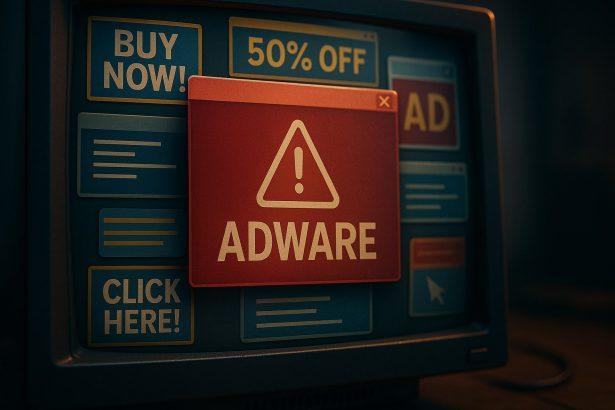Popup Blocker Max is a deceptive browser extension disguised as a legitimate ad-blocking tool, but in reality, it operates as adware. Rather than preventing pop-ups, this extension injects intrusive advertisements into your browsing sessions, leading to potential exposure to scams, malware, and privacy risks. This article provides a detailed breakdown of what Popup Blocker Max is, how it works, and how to eliminate it effectively.
Threat Overview
Popup Blocker Max falls under the adware category. This means its main function is to generate income through advertising, not to benefit the user. Despite advertising itself as a pop-up blocker, it performs the opposite function by showing excessive ads, redirecting users to unsafe websites, and collecting personal browsing information.
Threat Summary
| Category | Details |
|---|---|
| Threat Type | Adware, Pop-up Virus |
| Associated Domain | Not specified |
| Detection Names | Ads by “Popup Blocker Max” |
| Symptoms | Unwanted pop-up ads, browser redirects, sluggish system performance |
| Damage | Privacy invasion, potential malware infections, data theft |
| Distribution | Bundled software installers, deceptive pop-up ads, fake download pages |
| Danger Level | Moderate |
| Removal Tool | SpyHunter |
In-Depth Analysis
How Did I Get Infected?
Popup Blocker Max typically spreads through software bundling, a technique where it comes hidden in the installers of free programs downloaded from the internet. If users rush through installation steps without reviewing what’s being installed, they might unknowingly allow this extension onto their system. In some cases, deceptive pop-up ads may also trick users into installing it.
What Does It Do?
Once installed, Popup Blocker Max begins generating intrusive advertisements, including banners, pop-ups, and redirection pages. Instead of enhancing browser performance, it significantly deteriorates it. The adware may also monitor your browsing activity, tracking websites you visit, your search history, and potentially even sensitive data.
Should You Be Worried?
Yes. Even if it’s not as destructive as ransomware or Trojans, Popup Blocker Max poses real threats to your privacy and system stability. Clicking on its ads could lead you to phishing or malware-laden sites. Additionally, the data collected by the adware may be shared with third parties or used to deliver more personalized—yet intrusive—ads.
Manual Adware Removal Process (Windows & Mac)
Step 1: Identify and Uninstall Suspicious Applications
For Windows Users
- Open Task Manager by pressing
Ctrl + Shift + Esc. - Navigate to the “Processes” tab and search for unknown or high-resource-consuming processes.
- If you detect anything suspicious, right-click and select “End Task.”
- Go to
Control Panel>Programs>Programs and Features. - Locate and uninstall any unfamiliar programs.
For Mac Users
- Open
Finderand click onApplications. - Identify and move any suspicious applications to the
Trash. - Empty the
Trash. - Check
System Preferences>Users & Groups>Login Itemsfor unknown startup programs and remove them.
Step 2: Remove Malicious Browser Extensions
Google Chrome
- Open Chrome, click
Menu(three dots) >Extensions. - Locate and remove unknown extensions.
- Reset Chrome:
Settings>Reset settings> “Restore settings to their original defaults.”
Mozilla Firefox
- Click
Menu>Add-ons and themes. - Remove suspicious extensions.
- Reset Firefox:
Help>More troubleshooting information> “Refresh Firefox.”
Safari (Mac)
- Open Safari, go to
Preferences>Extensions. - Delete unknown extensions.
- Reset Safari:
History> “Clear History.”
Microsoft Edge
- Click
Menu>Extensions. - Remove any unfamiliar extensions.
- Reset Edge:
Settings>Reset settings> “Restore settings to their default values.”
Step 3: Delete Adware-Associated Files and Folders
For Windows Users
- Press
Win + R, type%AppData%, and press Enter. - Locate and delete suspicious folders.
- Repeat for
%LocalAppData%,%ProgramData%, and%Temp%.
For Mac Users
- Open Finder and press
Shift + Command + G, then enter~/Library/Application Support/. - Remove any suspicious folders.
- Repeat for
~/Library/LaunchAgents/,~/Library/LaunchDaemons/, and~/Library/Preferences/.
Step 4: Flush DNS Cache to Remove Adware Traces
For Windows Users
- Open
Command Promptas Administrator. - Type
ipconfig /flushdnsand press Enter.
For Mac Users
- Open
Terminal. - Enter
sudo killall -HUP mDNSResponderand press Enter.
Step 5: Restart Your System
Perform a reboot to apply the changes and ensure the removal process is complete.
Automatic Adware Removal Using SpyHunter (Windows & Mac)
For an effortless and effective solution, use SpyHunter, a powerful anti-malware tool designed to detect and remove adware completely.
Step 1: Download SpyHunter
Click the link to download SpyHunter: Download SpyHunter Here.
Step 2: Install SpyHunter
Follow the installation guide based on your operating system:
For Windows Users
- Run the downloaded
.exefile. - Follow the installation instructions.
- Launch SpyHunter and allow it to update its malware database.
For Mac Users
- Open the downloaded
.dmgfile. - Drag and drop SpyHunter into
Applications. - Open SpyHunter and let it update its database.
Step 3: Scan and Remove Adware
- Open SpyHunter.
- Click
Start Scan. - Wait for the scan to complete.
- Click
Fix Threatsto remove detected malware.
Step 4: Restart Your Computer
After SpyHunter removes all threats, restart your system to ensure all adware components are fully removed.
Conclusion
Popup Blocker Max is not the helpful tool it pretends to be. Instead, it disrupts your browsing experience and compromises your personal data. If you’re seeing an unusual surge in pop-ups or your browser is redirecting you to unknown sites, act quickly. Use a trusted anti-malware solution like SpyHunter to scan and remove this adware and secure your system.




